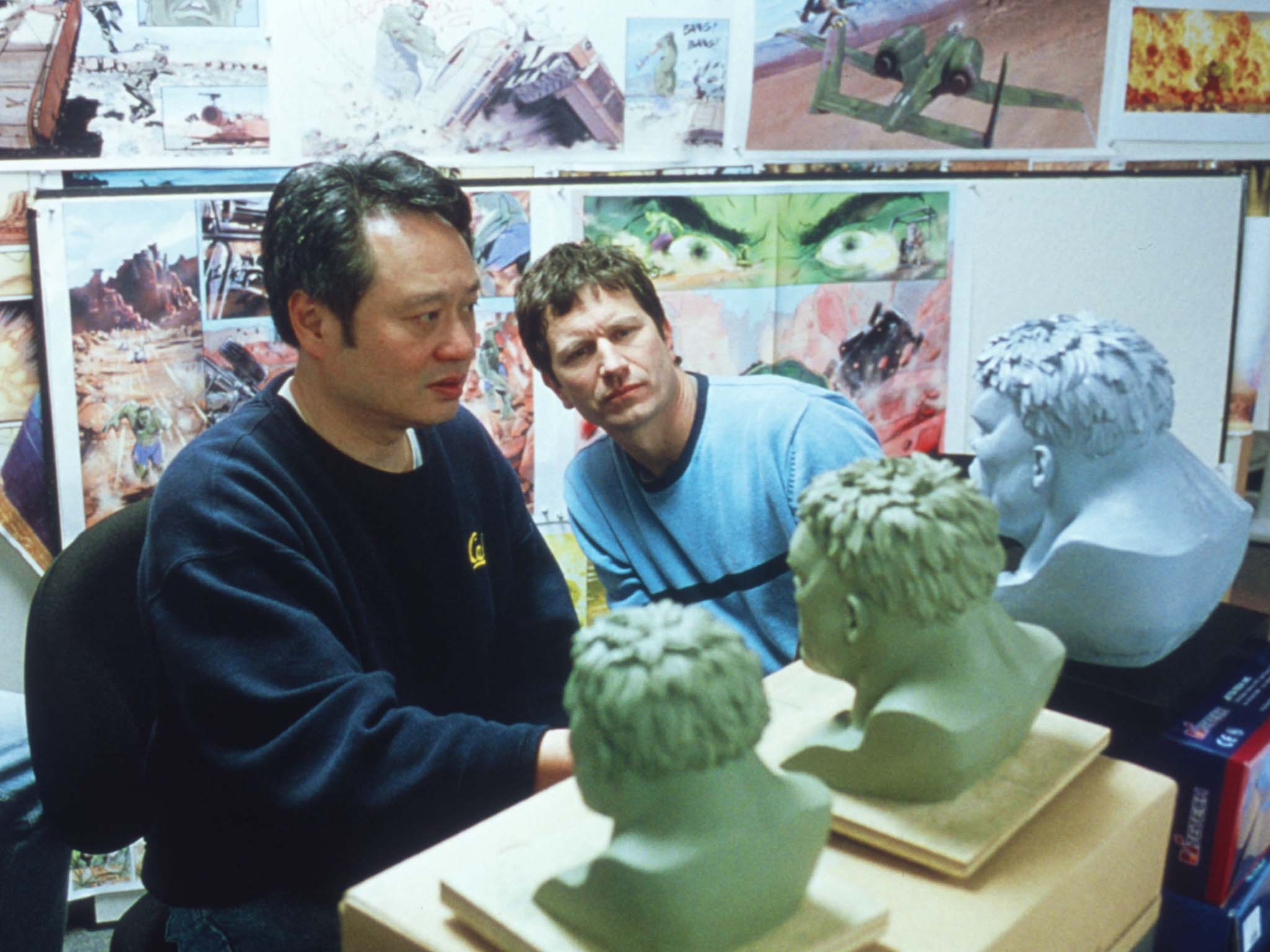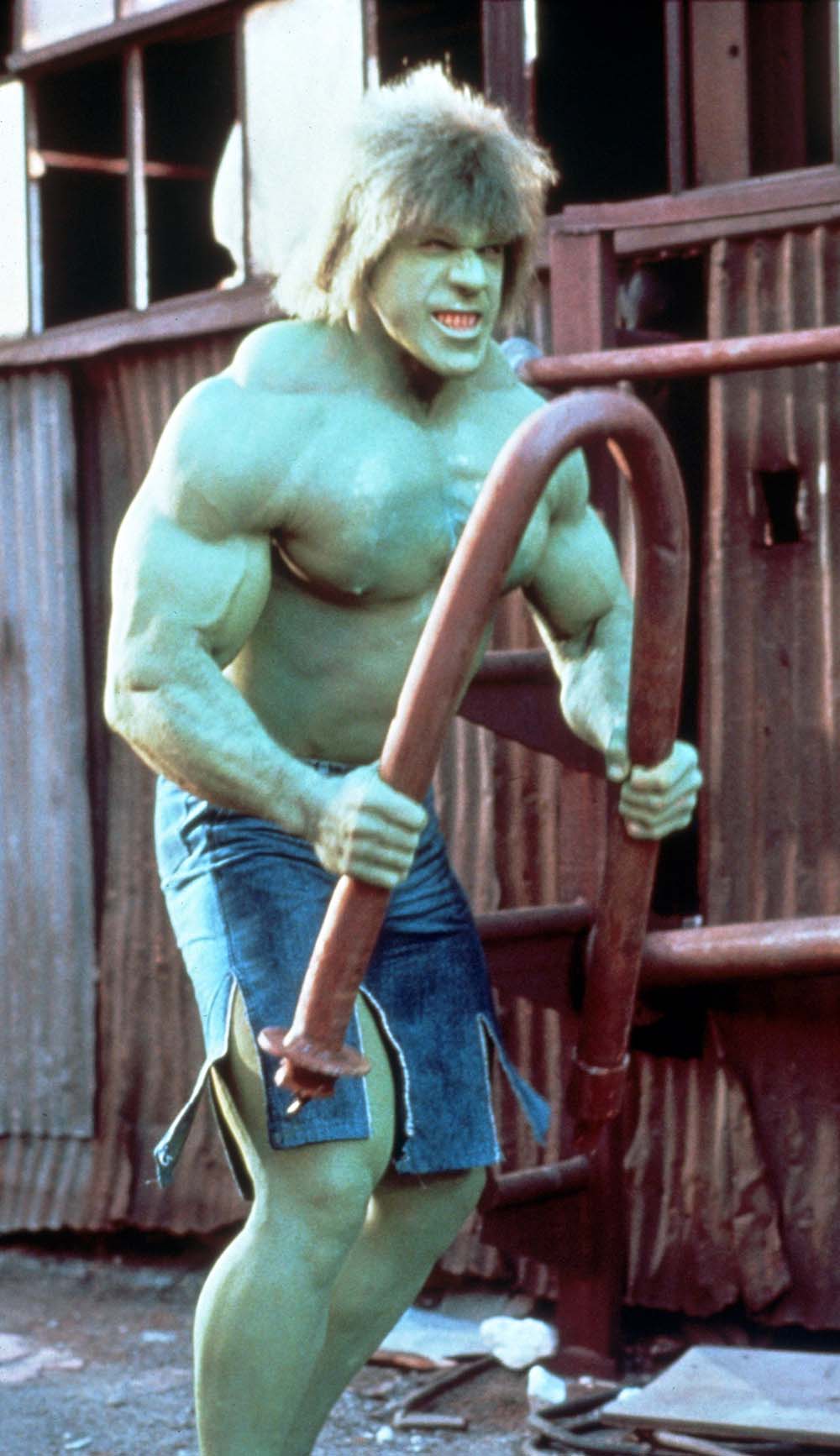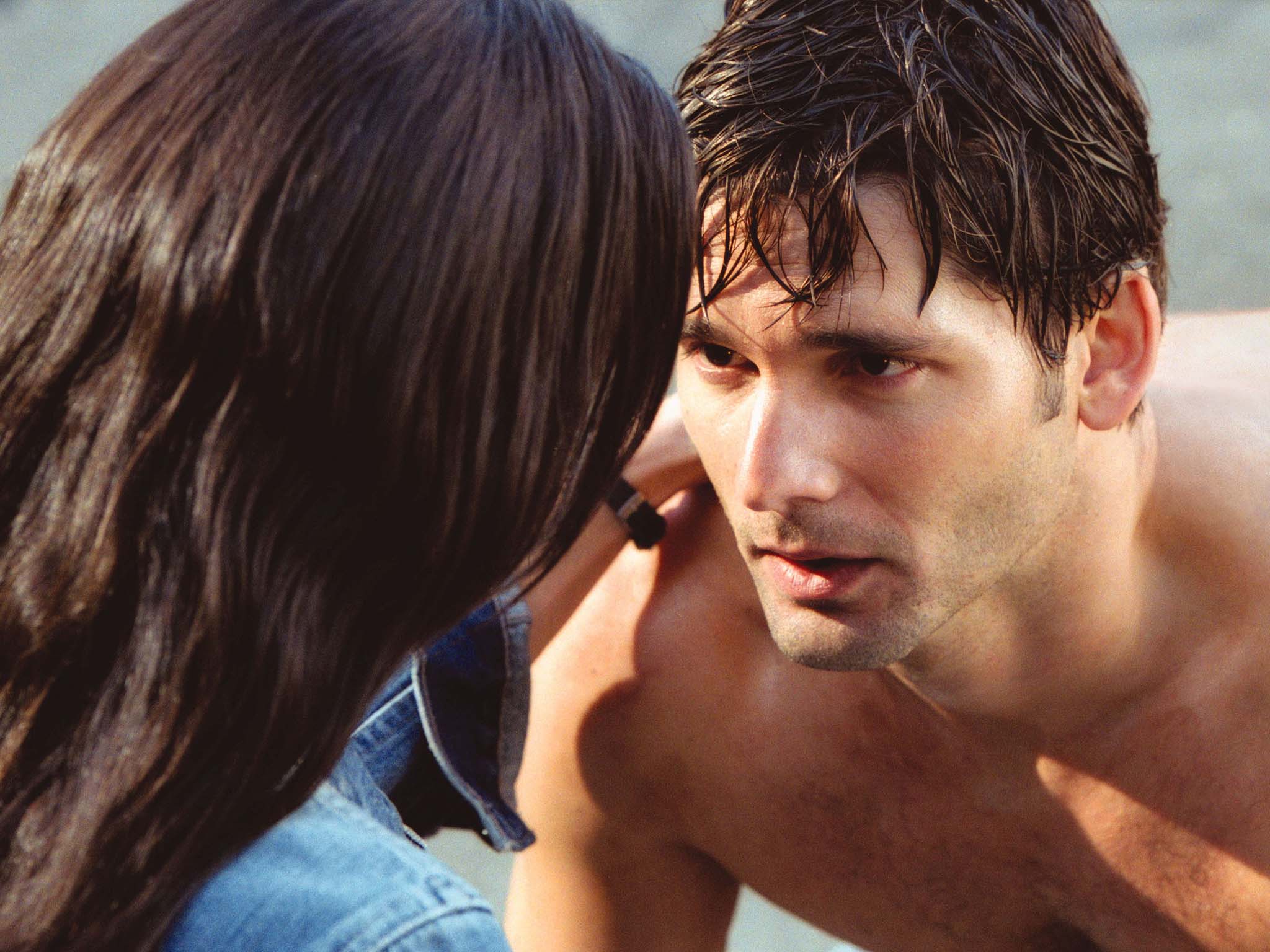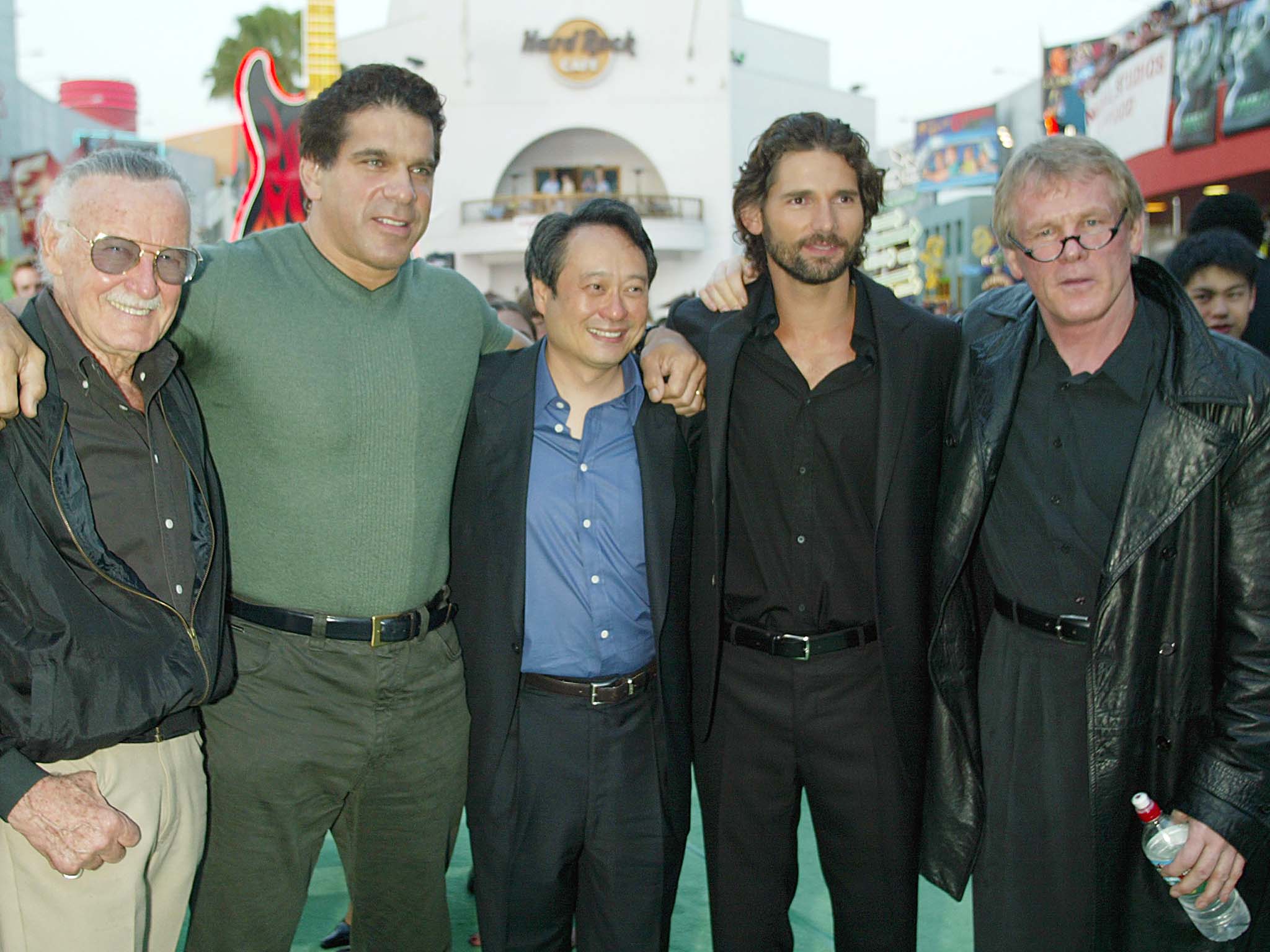
In the summer of 2002, producer and screenwriter James Schamus went to Times Square to see Sam Raimi’s Spider-Man. Schamus, a frequent collaborator with director Ang Lee, went for two reasons: to celebrate the star-making moment of Tobey Maguire, with whom Lee and Schamus worked on The Ice Storm; and to “scope out what was going in Marvel-land”. Lee and Schamus were deep into production on Hulk, a rival superhero smackdown now marking its 20th anniversary.
Hulk – which starred Eric Bana as Bruce Banner, the scientist with severe anger management issues – had been more than a decade in development. These were the old times, before the Marvel Cinematic Universe had taken over – when Marvel’s top-billed characters were in the hands of other studios, and filmmakers were scrambling to figure out the formula of blockbuster cinema’s hot new trend.
For Schamus, that all changed in the closing seconds of Spider-Man. Having dispatched the Green Goblin, Spidey takes one final, triumphant swing through New York City and lands in front of the American flag. “In my mind it created the genre,” Schamus tells me. Leaving the cinema in Times Square, Schamus called Lee and told him: “I think we’re in a little trouble…” The audience, said Schamus, would go to watch superhero movies expecting to see “the American flag version” from that point on. “And that’s not what we’ve got!”
Indeed, Hulk – which released to mixed reviews in June 2003 – is a curiosity of pre-MCU super-heroics: a film that, for the most part, eschews the expected hulk-smashery for a more contemplative exercise in soul searching. “Ang was committed to the abstract and ethereal outsider version,” says Schamus. But Lee – who even 20 years on seems an unlikely choice for Hulk (his films either side were Crouching Tiger, Hidden Dragon and Brokeback Mountain) – was also committed to the film’s major selling point. That being the once fanboy-quivering prospect of seeing the Hulk brought to life – a transformation that didn’t involve slapping green paint on a bodybuilder.
“Ang Lee was such a team player, he decided to suit up and do a bunch of the motion capture himself,” says Aaron Ferguson, then a creature supervisor at Industrial Light & Magic. “He was able to channel his inner Hulk and storm around.”
Hulk began development in the early 1990s, with multiple screenwriters writing multiple drafts and various directors attached. Different proposed scenarios would have seen Hulk battling terrorists, insect men, sharks, or his giant-headed nemesis, The Leader. Leaked details were also subject to early examples of toxic online fandom – the kind of entitled, gate-keeping bile that spews up around certain pop culture properties. Universal had blown a reported $20m on pre-production before Lee even joined. Schamus remembers there being “15 or 16 prior drafts” when they signed on. “It was just all over the map,” he adds. Lee may have been an unlikely candidate for Hulk, but he took on the project – in part – out of cinematic wonderment. Their attitude with their projects by that point, says Schamus, was “that sounds cool. We love movies; let’s go make movies!”
The script I wrote, weirdly, was probably more Marvel-y than what you ended up seeing. There was more of that self-aware wisecracking!— James Schamus
Schamus had previous experience, having worked (uncredited) on the script of 2000’s X-Men, the film that set the superhero boom in motion. Schamus recalls that Marvel Studios at the time consisted mostly of CEO/producer Avi Arad, with Kevin Feige – now the mastermind of the MCU – as a junior assistant. “I would notice him and think, ‘Oh, this guy, he knows what he’s doing!’” laughs Schamus.
With Schamus rewriting the script himself, Hulk followed the long-held movie tradition of tampering with the original comic (see also: Spider-Man’s organic web-shooters and Power Ranger-like Green Goblin; the X-Men not being man enough for yellow spandex). In the Incredible Hulk comic, first published in 1962, Bruce Banner is a scientist who – while saving someone else’s life – gets caught in the blast of a gamma bomb, which causes him to transform into the Hulk. Schamus was free from the restraints of hardcore fandom (“I didn’t grow up as a comic-book geek kid,” he says. “It wasn’t formative to me”), but he did go back to the comics. He was taken by a 1980s storyline that introduced Banner’s abusive father, who killed the future Hulk’s mother – the source of grown-up Banner’s anger issues.
The 2003 movie follows loosely: Banner’s father, David (Nick Nolte) is a government scientist who – against orders – performs an experiment on himself and passes mutant genes to his son. Years later, Bruce (Bana) – now a nanotech scientist – is involved in a gamma accident that triggers the mutant cells. Like the Eighties comic book, this version of Banner witnessed his father murder his mother. The real cause of the monster is the repressed memory of this incident.

Watch Apple TV+ free for 7-days
New subscribers only. £6.99/mo. after free trial. Plan auto-renews until cancelled

Watch Apple TV+ free for 7-days
New subscribers only. £6.99/mo. after free trial. Plan auto-renews until cancelled
With so many previous script drafts and writers, the film was subject to a tricky arbitration over the writing credits. Certain elements, including the abusive father, had shown up in previous drafts. In the end, Schamus shared the writing credit with previous scriptwriters Michael France and John Turman. The arbitration was detailed in a New Yorker cover story. Two decades on, Schamus is pragmatic about the controversy. He thinks there was some political wrangling in the Writers Guild. “Also, whatever,” he says, laughing.

Schamus recalls pushing to cast Bana after seeing him in Chopper. Bana, as wonderful as he is, gets eaten alive by Nolte, who plays his onscreen father with off-kilter, sunken-eyed menace – despite the inherent ridiculousness of being a mad scientist with three giant mutant dogs (including a killer poodle). Discovering his own superhuman ability – to fuse with any material he lays his hands on – he becomes a reworking of the comics’ Absorbing Man.
“I really adored Nick,” says Schamus. “He was definitely in the process of becoming the character that he’s now more known as – after the mugshot that happened when we were in post [he was arrested for driving while high on the date rape drug, GHB]. But he doesn’t show up on screen without giving everything. Ang let him chew the scenery right down to the floorboards.”
Co-stars include Jennifer Connelly as Banner’s long-time sweetheart, Betty Ross; Sam Elliot as Hulk’s military adversary (and Betty’s father), Thunderbolt Ross; and Josh Lucas – the only person in the film who seems to be having some fun – as a soldier-turned-corporate snide, whose job it is to bully Banner then get thrown around by the Hulk. There are cameos, too, from Hulk co-creator Stan Lee (naturally) and Lou Ferrigno, the 6ft 5in bodybuilder who played the Hulk (with the help of green grease paint) in the 1970s TV series. The original Hulk comic was cancelled after six issues. It was actually the TV show that made the Hulk a pop culture icon, as summed up by its most iconic line: “Don’t make me angry, you wouldn’t like me when I’m angry”. The 2003 Hulk saves the line for the very last scene.

At one stage, the VFX maestros at Industrial Light & Magic considered going down the Ferrigno route to create the Hulk – an ambitious project in the early Noughties. “There was a lot of wondering what we had gotten ourselves into – was this more than we could do?” Aaron Ferguson says. “There were lots of people shaking their heads and a lot of crazy ideas. One idea was that maybe we should do it as a guy in a suit and adjust it all after [digitally]. People were like, ‘That’s not gonna work!’”
One major challenge, recalls Ferguson, is that ILM hadn’t quite caught up with the latest evolution in CGI tech. Even then, the techniques ILM was using to create the Hulk were old school. The colour green was a problem, too. “We’d sit around with the dailies and think, ‘What is wrong with this shot?’” says Ferguson. “A co-worker said ‘look at this’ and changed the monitor so it was just black and white. Everyone was like, ‘That looks so much better!’ The green breaks the illusion of it being human. No matter what shade you use, somewhere in your mind there’s something wrong with it.”
For Ferguson, the best part of the job was working with Lee. “An all-in kind of guy,” says Ferguson. “He was like, ‘I’m coming and staying at the studio and working with you guys.’ We had dailies with him every day. He was full of ideas.”
Twenty years on, the Hulk CGI looks better than you might expect – though certainly primitive. “I don’t want to say cringeworthy,” says Ferguson, “but there’s dated material in there.” A fight with the mutant dogs – which felt like a cop out in lieu of a proper superhero vs supervillain punch-up at the time – is a highlight. And a desert battle between Hulk and the US army feels like a bit of freeform Hulk action.

But for all of Lee’s stomping around in mo-cap Hulk mode, the film – about a man who turns into a green monster, lest we forget – is jarringly straight-faced. “The script I wrote, weirdly, was probably more Marvel-y than what you ended up seeing,” says Schamus. “There was more of that self-aware wisecracking! By the time you got the finished film it was taking itself very seriously.”
It’s best demonstrated by the film’s first Hulk-out scene – the moment that everyone’s been waiting for. It’s not part of an all-action spectacle, like Avengers Assemble’s helicarrier wallop-fest, but a scene of Bana’s troubled scientist sitting alone, having a good old think about who he really is deep down.
Lee is also one of the few directors – alongside Tim Burton and Sam Raimi, perhaps – to make a film that actually resembles a comic book. Using split screen and other techniques, Lee replicates comic panels and gives scenes a sense of propulsion. The sound, says Schamus, was designed to draw you to different places on screen.
It’s as if Hulk leapt forward. We didn’t get the straight-up, all-action Incredible Hulk movie – something more like the 2008 film starring Edward Norton. Instead, Lee went straight to the subversive reinvention – like skipping Batman and making The Dark Knight first; or giving us Logan before X-Men. But some critics didn’t have the same foresight. The New York Times said “incredible, but only in a negative sense: incredibly long, incredibly tedious, incredibly turgid”. The Independent called it “a decent but doomed attempt to humanise a debased genre”.

“I think the studio was much more surprised than I was,” Schamus says about the reaction. “To their credit, the money people and executives were very supportive and really loved the film. I think it was very sobering to them to crash against the initial wave of disappointment. For me, it was what I thought was going to happen.”
Still, Hulk made money – $245m – and Schamus put together ideas for a sequel. Instead, the character was rebooted for the MCU with Norton’s unfairly-unloved The Incredible Hulk five years later. Banner was then recast with Mark Ruffalo for Avengers team-ups. Universal still owns the distribution rights for Hulk-led films, which means Hulk plays a supporting role in MCU adventures. It might be for the best. The Bana and Norton films prove that he’s a tricky solo act.
Hulk is best appreciated within the context of 20 years’ worth of superhero cinema that followed – to see how, like the Hulk himself, it’s an outsider. “It’s not your typical film,” says Ferguson. “It’s kind of a weird movie. I can understand why Marvel wouldn’t want to do something like this again. But if directors were given a little more creative freedom, maybe they wouldn’t see the burnout we’re starting to have with superhero films – they’re all kind of the same.”







